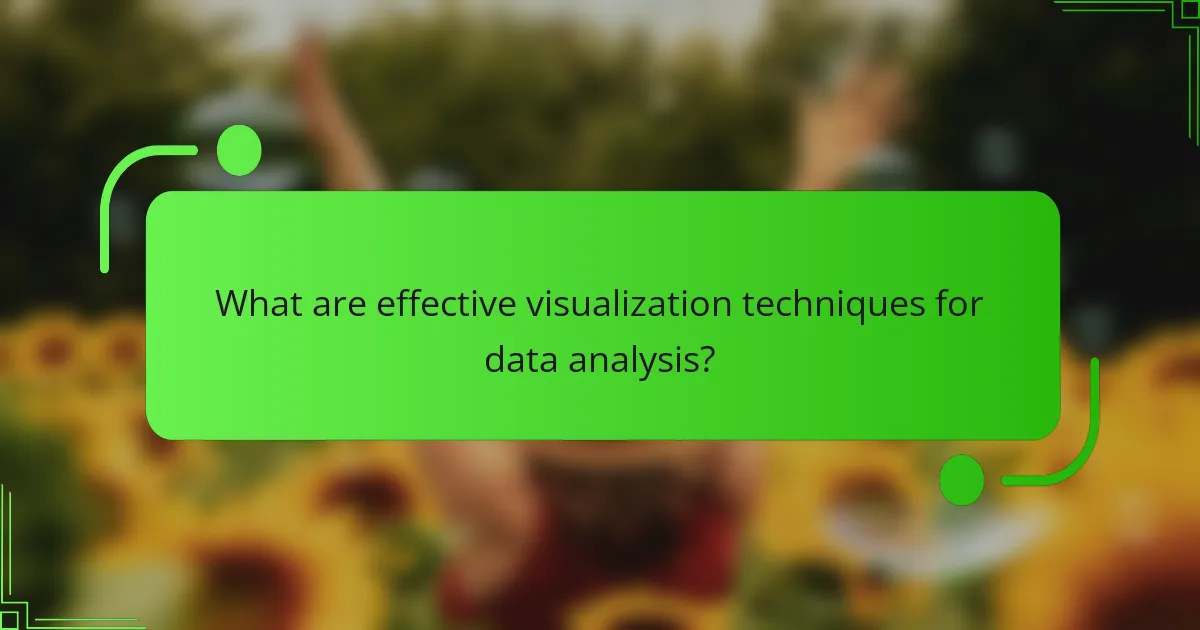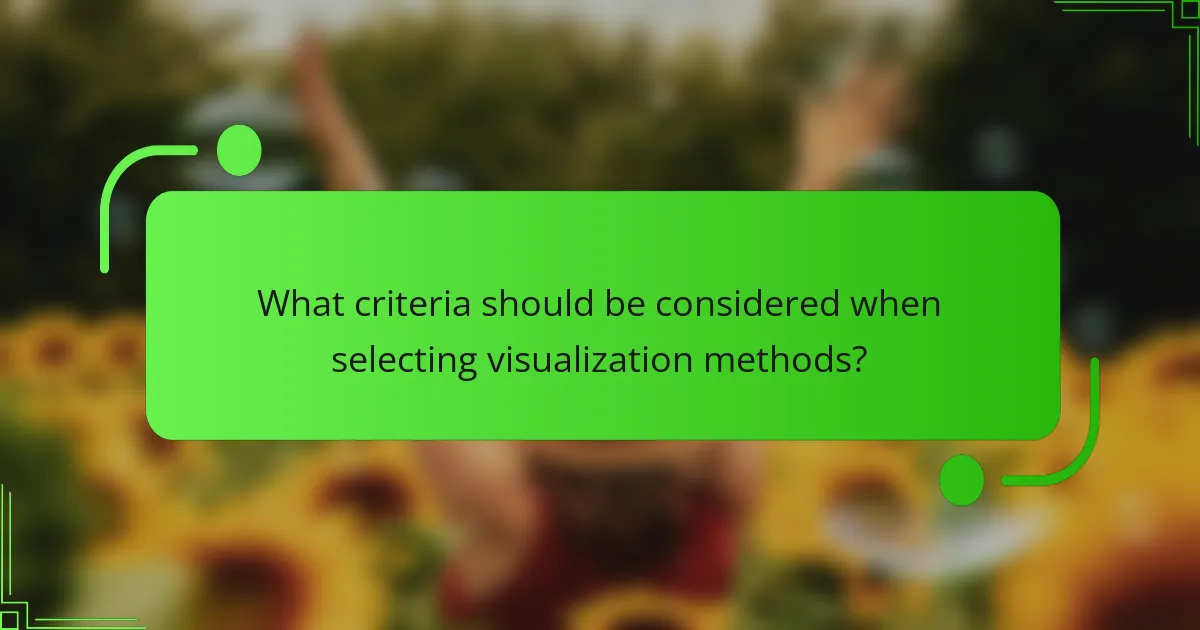Visualization techniques play a crucial role in data analysis by transforming complex data sets into clear, understandable visual formats. These methods not only facilitate the identification of patterns and trends but also enhance decision-making by allowing stakeholders to quickly grasp essential insights. By simplifying information presentation, visualization techniques improve both understanding and retention, ultimately leading to more informed choices.

What are effective visualization techniques for data analysis?
Effective visualization techniques for data analysis include various graphical methods that help interpret complex data sets. These techniques enable analysts to identify patterns, trends, and insights quickly, facilitating better decision-making.
Bar charts for categorical data
Bar charts are ideal for displaying categorical data, allowing for easy comparison across different groups. Each bar represents a category, with its length corresponding to the value it represents, making it straightforward to visualize differences.
When using bar charts, ensure that categories are clearly labeled and that the scale is consistent. Avoid cluttering the chart with too many categories; a good rule of thumb is to limit it to five to ten categories for clarity.
Heat maps for density representation
Heat maps use color gradients to represent data density or intensity across two dimensions, making them effective for visualizing large data sets. They are particularly useful in identifying areas of high and low concentration, such as customer activity on a website.
To create an effective heat map, choose a color palette that is intuitive and accessible. Ensure that the legend is clear, as it helps viewers understand the data’s meaning at a glance.
Line graphs for trend analysis
Line graphs are excellent for showing trends over time, making them suitable for time series data. Each point on the graph represents a data value at a specific time, and connecting these points with lines helps visualize changes and trends.
When creating line graphs, use a consistent time interval and avoid overplotting by limiting the number of lines. A maximum of three to five lines can help maintain clarity while still providing comparative insights.
Pie charts for proportional data
Pie charts display proportions of a whole, making them useful for showing how different categories contribute to a total. Each slice represents a category’s percentage of the total, allowing for quick visual comparisons.
Limit the number of slices to five or six to avoid confusion. Additionally, consider using a legend to label slices, as this can enhance understanding, especially when dealing with similar-sized segments.
Scatter plots for correlation insights
Scatter plots are effective for visualizing relationships between two quantitative variables, helping to identify correlations. Each point represents an observation, with its position determined by the values of the two variables being compared.
To enhance scatter plots, consider adding a trend line to illustrate the overall direction of the data. Be cautious of outliers, as they can skew interpretations; it may be helpful to highlight or annotate these points for clarity.

How do visualization techniques impact decision-making?
Visualization techniques significantly enhance decision-making by transforming complex data into understandable visual formats. This clarity allows decision-makers to quickly grasp information, identify trends, and make informed choices based on insights derived from the visuals.
Enhances comprehension of complex data
Visualization techniques simplify the interpretation of intricate datasets by presenting them in graphical formats such as charts, graphs, and infographics. This approach reduces cognitive load, allowing individuals to focus on key patterns and relationships within the data.
For example, a bar chart can effectively illustrate sales performance across different regions, making it easier to compare and analyze than a lengthy table of numbers. Using color coding and labels further aids in highlighting critical information.
Facilitates quicker insights
By using visual representations, stakeholders can derive insights in a fraction of the time it would take to analyze raw data. Visuals can condense large amounts of information into digestible formats, enabling faster recognition of trends and anomalies.
For instance, a dashboard displaying real-time metrics allows managers to quickly assess performance indicators without sifting through extensive reports. This immediacy can lead to timely decisions that capitalize on emerging opportunities or address issues promptly.
Improves stakeholder communication
Effective visualization fosters better communication among stakeholders by providing a common language through which complex ideas can be conveyed. Visuals can bridge gaps in understanding, ensuring that all parties are aligned on key messages and data interpretations.
Using visuals in presentations can enhance engagement and retention of information, making it easier for stakeholders to discuss strategies and outcomes. For example, a well-designed pie chart can succinctly illustrate market share distribution, facilitating discussions on competitive positioning.

What are the benefits of using visualization techniques?
Visualization techniques enhance understanding and retention of information by presenting data in a visual format. They simplify complex data sets, making it easier for individuals to grasp insights quickly and effectively.
Increases data retention
Visualization techniques significantly improve data retention by allowing individuals to process information visually. Studies suggest that people remember visuals better than text, with retention rates potentially increasing by up to 80% when data is presented graphically.
Using charts, graphs, and infographics helps to create mental associations, making it easier to recall information later. For instance, a pie chart can help viewers quickly understand proportions, while a bar graph can illustrate trends over time.
Boosts engagement with data
Engaging with data through visualization techniques captures attention and encourages interaction. Visuals can transform dull statistics into compelling stories, prompting viewers to explore and analyze the data further.
For example, interactive dashboards allow users to manipulate data views, fostering a deeper connection with the material. This engagement can lead to increased curiosity and motivation to learn more about the subject matter.
Supports data-driven decisions
Visualization techniques support data-driven decisions by presenting clear insights that inform strategic choices. When data is visualized effectively, decision-makers can quickly identify trends, patterns, and outliers that may not be apparent in raw data.
For instance, a sales team might use visual analytics to track performance metrics over time, enabling them to adjust strategies based on real-time insights. This approach minimizes guesswork and enhances the overall effectiveness of decision-making processes.

What criteria should be considered when selecting visualization methods?
When selecting visualization methods, consider the data type and structure, the audience and context, and the purpose of the visualization. These criteria help ensure that the chosen method effectively communicates the intended message and engages the viewers.
Data type and structure
The type of data you are working with—whether categorical, numerical, or temporal—greatly influences the visualization method. For instance, bar charts are suitable for categorical data, while line graphs excel in displaying trends over time. Understanding the structure, such as whether the data is hierarchical or relational, also guides the choice of visualization.
Additionally, consider the volume of data. Large datasets may require aggregation or filtering to avoid clutter, while smaller datasets can be displayed in more detail. Always aim for clarity and simplicity to enhance comprehension.
Audience and context
Knowing your audience is crucial in selecting an appropriate visualization method. Different audiences may have varying levels of expertise and familiarity with the subject matter. For example, a technical audience might appreciate detailed scatter plots, while a general audience may prefer simpler pie charts.
Context also matters; consider where and how the visualization will be presented. A presentation might call for dynamic visuals, while a printed report may benefit from static images. Tailoring the visualization to the audience’s needs enhances engagement and understanding.
Purpose of the visualization
The purpose behind the visualization should drive your method selection. Are you aiming to inform, persuade, or explore data? For instance, if the goal is to highlight comparisons, bar charts or column charts are effective. If you want to show relationships, consider scatter plots or bubble charts.
Additionally, think about the desired action from the audience. If the aim is to prompt decision-making, clarity and emphasis on key data points are essential. Always align the visualization method with the intended outcome to maximize impact.

What tools are available for creating visualizations?
Several tools are available for creating visualizations, each offering unique features tailored for different needs. Popular options include Tableau, Microsoft Power BI, and Google Data Studio, which cater to various aspects of data visualization from interactive dashboards to business analytics.
Tableau for interactive dashboards
Tableau is a leading tool for creating interactive dashboards that allow users to explore data visually. It supports drag-and-drop functionality, making it user-friendly for those without extensive technical skills. Users can connect to various data sources, including spreadsheets and databases, and create dynamic visualizations that update in real time.
When using Tableau, consider the complexity of your data and the audience’s needs. For instance, dashboards can include filters and parameters to enable users to customize their views. However, be cautious of overloading dashboards with too much information, which can overwhelm users.
Microsoft Power BI for business analytics
Microsoft Power BI is designed for business analytics, providing tools to transform raw data into insightful reports and visualizations. It integrates seamlessly with other Microsoft products, making it a convenient choice for organizations already using the Microsoft ecosystem. Power BI allows users to create interactive reports that can be shared across teams.
To maximize Power BI’s effectiveness, leverage its data modeling capabilities to create relationships between different data sets. This can help in generating more comprehensive insights. Avoid using overly complex visuals that may confuse stakeholders; instead, focus on clarity and relevance in your reports.
Google Data Studio for web data visualization
Google Data Studio is a free tool that specializes in web data visualization, particularly useful for digital marketing analytics. It allows users to create customizable reports that can pull data from various Google services, such as Google Analytics and Google Ads. The collaborative features enable teams to work together in real time.
When using Google Data Studio, take advantage of its templates to streamline the report creation process. Ensure that the visualizations align with your marketing goals and KPIs. Avoid cluttering reports with excessive metrics; instead, focus on key performance indicators that drive decision-making.

How can visualization techniques be applied in marketing?
Visualization techniques in marketing enhance data interpretation and decision-making by presenting information in a clear and engaging manner. These methods help marketers identify trends, understand customer behavior, and communicate insights effectively.
Benefits of visualization techniques in marketing
Visualization techniques offer numerous benefits in marketing, such as improved clarity and faster insights. By transforming complex data into visual formats like charts and graphs, marketers can quickly grasp key trends and make informed decisions.
Additionally, visuals can enhance storytelling, making marketing campaigns more compelling. Engaging visuals can capture audience attention and increase retention of information, leading to better customer engagement.
Common visualization methods used in marketing
Several visualization methods are commonly used in marketing, including bar charts, pie charts, heat maps, and infographics. Bar charts are effective for comparing quantities, while pie charts illustrate proportions of a whole.
Heat maps can visualize customer interactions on websites, highlighting areas of high engagement. Infographics combine visuals and text to convey complex information succinctly, making them ideal for sharing on social media.
Best practices for implementing visualization techniques
To effectively implement visualization techniques in marketing, start by defining your objectives and the audience’s needs. Choose the right type of visualization that aligns with your data and message.
Keep visuals simple and avoid clutter to ensure clarity. Use consistent color schemes and labels to enhance understanding. Regularly test your visuals with target audiences to gather feedback and make necessary adjustments.


